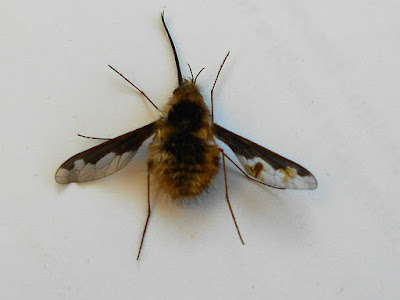At various points along the track Dark-edged Bee-flies, Bombylius major, were seen visiting flowers, particularly clumps of Primroses, Primula vulgaris. Often plants in the vicinity of houses are of doubtful provenance but there was little doubt that this was the genuine wild plant.
 |
| Primroses flower in a hedgerow near Badby Wood. 7 April, 2017 |
The bee-fly is indeed very bee-like with its body covered in golden brown fur and that people often mistake them for a genuine bee is perfectly understandable, particularly when it is obviously imbibing nectar.
 |
Bombylius major showing its very long proboscis. Taken from primroses
near Badby Woods. 7 April, 2017
|
As my photograph shows, the bee-fly only has two wings compared with the four of a genuine bee, but this is hardly obvious when the insect is hovering with the wings simply a blur. It tends to hover in the manner of a humming bird but its body is only a centimetre or so in length.
With the golden brown of the bee flies and the pale yellow of the primroses it was a day for yellowish hues.
 |
Once regarded as a species of Dead-nettle (as Lamium galeobdolon) Yellow
Archangel was abundant as I began my walk. 7 April, 2017
|
Yellow Archangel, Lamiastrum galeobdolon, grew in masses on damp banks. It is often found as a garden escape but the fact that the antiquarian and historian George Baker (1781-1851) recorded it from Badby in 1822 suggests it is genuinely native here. Celandines, Ficaria verna, were too abundant to photograph and the picture shown is that of a group seen a few days earlier.
 |
| Celandines grew in patches throughout. |
I was not done with yellows for where the soils consisted of damp clay, plants of Coltsfoot, Tussilago farfara, were in bloom. Its leaves were once much used by herbalists as a demulcent, i.e. employed to soothe irritable coughs, and as an expectorant. The leaves are hoof-shaped, giving the plant its common name, but these do not appear until the plant has almost finished flowering.
 |
| Coltsfoot grew in damp clay. Near Badby Woods. 7 April, 2017 |
My sweep net had failed to secure anything to cause excitement. Silpha atrata, one of the burying beetles and known as the Black Carrion Beetle, had ended up in my net, but this is a widespread insect. Nevertheless it is an interesting one. It has a very small head in relation to the rest of its body and this enables it to get deep into the shell of snails in order to devour them.
 |
Silpha atrata taken from beside a footpath near Badby Woods.
7 April, 2017
|
It was now well into the afternoon and I had yet to walk home to Daventry. It isn't very far as the crow, Corvus corone, flies, but I'm not a crow, and wasn't looking forward to that hill leading out of Badby. Anyway I set off at brisk trudge and eventually made it, having passed thousands of dandelions - bright yellow of course.
No comments:
Post a Comment